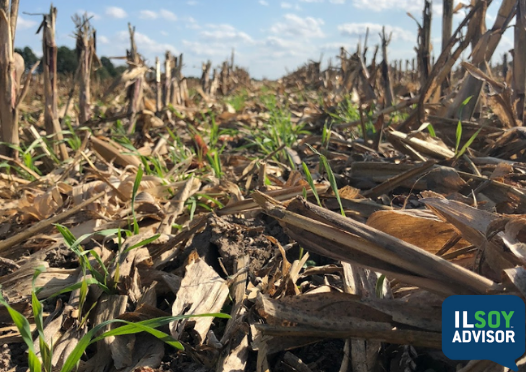ILSOYADVISOR POST
Stop Treating Your Soil Like Dirt
The world is brimming with news and information about soil health. But what best defines soil health? And, how do farmers best measure and improve it over time?
First and foremost, it’s important to consider that healthy soil is comprised of physical, chemical and biological forces that interact to influence soil properties, says Will Brinton, Ph.D., environmental scientist and founder of Woods End Soil Laboratory.
“Soil isn’t something that’s just put there. Soil is constantly changing and responding to the environment,” he says. “Soil health isn’t a ‘thing’ like nitrogen or phosphorus is a ‘thing.’ Soil health is the interaction and relationship of many ‘things’ that form the whole of your soils.”
Brinton says embracing soil health should go beyond a traditional soil-management perspective that focuses on individual fertility components. Instead, farmers should adopt a more inclusive approach that addresses all of the properties that make up the entire system. Attention to soil health also should center on each field’s diverse ecosystem, giving careful consideration to making and executing plans for the farm all year long — and for the decades to come.
Consider Test Types
Traditional soil tests and newer soil-health tests do not measure the same parameters. Where soil fertility tests are important tools for providing timely results for key indicators like phosphorus and potassium levels and micronutrients, soil-health tests tell more about the soil’s story.
“For example, carbon biology has a delayed effect compared to nutrients,” says Brinton. “As we diversify farming with the addition of tools such as cover crops, we’re seeing a lot of biomass nutrients that are not going to be revealed in a soil fertility test.”
“Traditional soil tests look at the chemical properties of soil, and that’s helpful,” notes Jim Isermann, Soil Health Partnership field manager. “However, soils include physical and biological factors, too. Right now, the main indicator on a standard soil test for biologic and physical characteristics is organic matter. Many farmers want to go further in-depth and are turning to soil-health tests. But these are very new, and we need to understand how to use the results."
Isermann says the trend may continue as interest in soil health remains on an upward trajectory.
“Farmers are very interested in a deeper soil-health test,” adds Doug Miller, vice president of Midwest Bio-Tech Inc., in Erie, Ill. Midwest Bio-Tech will soon come online as the first lab in Illinois solely dedicated to testing soil health. “Farmers want to know where they are at.”
Variations in soil types will affect soil-health test objectives. “Soils are different from north to south, so soil-health testing procedures and soil-health needs will be different,” says Miller. “Some farmers, based on location, will focus more on building organic matter, for example.”
Soil-health testing will allow farmers to consider more comprehensive and specific assays that delve into parameters that include soil respiration (CO2 exchange), stored organic nitrogen and aggregate stability to provide a deeper level of understanding of soil performance.
“We now have some very good tests to help us measure these factors,” says Isermann. “The next step is to determine how we use that data to make on-farm decisions.”
No Single Recipe
Brinton, Isermann and Miller agree a sound approach is to take the long view on soil heath, as research and results over time tell the story of success.
For instance, with the complexity of the tests and soil-health factors, farmers and agronomists will not likely be able to order a single test that comes with a single set of recommendations they can use to make cropping and management decisions.
“Farmers are used to getting recipes (soil fertility results) to fix things,” says Brinton. “But because soil health is not about individual things, this prescriptive strategy no longer fits. Instead, soil-health monitoring will require different types of analyses and a holistic attitude.”
“We’ve been using soil-health testing for three years and we’ve learned so much in that time,” adds Miller. “It’s important to keep in mind that weather and climate conditions play a big role in biological activity, too, along with soil moisture and even test timing. While important considerations for traditional soil testing, these are even more so for soil-health testing.”
Brinton stresses to farmers that soil health is under their control. He encourages farmers to get to know their soils and evaluate more than just topsoil to be successful.
Soil Health Partnership Develops Database
The Soil Health Partnership (SHP) is evaluating soil-health test results for 30 sites in Illinois that are part of 111 sites across the Midwest to establish soil-health baselines, better understand the various components and how they work collectively.
“We’re building a large data set. The goal is to better establish how to rank certain parameters so farmers can positively affect the health of their soils, while better understanding which factors they can and cannot change,” says SHP Field Manager Jim Isermann. “Data can help us understand how to influence specific soil-health factors. Illinois farmers will be able to access data individualized for the state. That information can help benchmark a farm’s results for factors such as aggregate stability, set long-term goals and aid management decisions.”
Tackle These Soil Health Test Tips
In addition to standard soil fertility tests to determine soil nutrient levels and pH, consider adding these four tests to effectively benchmark and monitor soil health. Follow the specific sampling procedures outlined by each test and take samples from different depths. Depending on root depth, some samples may need to be taken at 20 to 24 inches.
- Test for soil organic matter or soil carbon; two different ways of measuring the same thing. If available, get results for both.
- Obtain soil microbial activity.
- Test soil respiration (CO2).
- Determine total organic nitrogen in the soil (must request specifically).
To take your monitoring even further and build a total picture of your soils, add in the Natural Resources Conservation Service soil survey data available at: https://websoilsurvey.sc.egov.usda.gov/App/HomePage.htm.





Comments
Add new comment